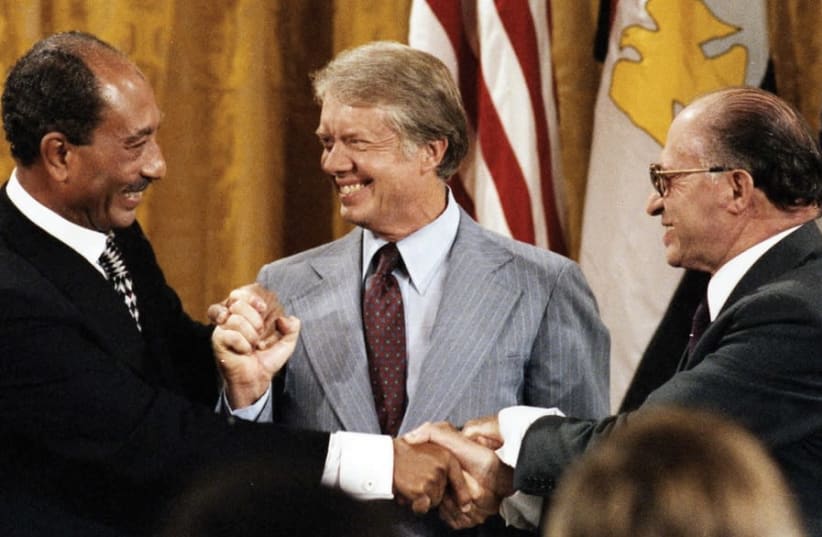It’s hard not to see echoes of this today. Carter, like Barack Obama or Donald Trump, was a polarizing figure. He wanted to be a transformative president, and yet those lofty goals were largely frustrated, and he has spent the decades after his four years in office trying to redeem his image.
Eizenstat – Carter’s White House domestic policy adviser – is well placed to write this biography. Carter was elected in 1976, a little over a decade after JFK was assassinated. The Democratic Party had been flailing around since 1968 searching for another Kennedy after Robert Kennedy was murdered. When Carter was elected, he had a large number of challenges on his plate. The US was riven with self-doubt after the Vietnam defeat and economic disaster was wreaking havoc.
“It is conventional wisdom that Jimmy Carter was a weak and hapless president,” Eizenstat writes. “But I believe that the single term served by the 39th president of the US was one of the most consequential in modern history.”
Carter was obsessive. He was obsessed with understanding the environment, the oil crises, the economy and other issues – and that followed him into the Middle East.
“Jimmy Carter made the Middle East peace process his top priority among all the foreign-policy issues confronting the United States,” Eizenstat wrote, adding that the issue of Israel and peace in the region was a personal one for him. As the administration took shape, those around Carter were split into differing camps of hard-liners and moderates on the issue.
The US in the 1970s was torn between its historic support for Israel and the demands of the Arab states which opposed Israel; Carter himself had a strange relationship with Israel.
“Support for a state for the Jewish people in their biblical homeland flowed directly from his Baptist upbringing,” said Eizenstat, but this messianic view of Israel and the role of the Jewish people may not have been helpful in crafting a decent policy. Eizenstat noted that Carter had another burden on his shoulders. He had never met a Palestinian before coming into office, but he came to see them as “living in conditions like the blacks in the South in which he grew up, but that the Israeli military treats them worse than the white police treat blacks” – a toxic mix of paternalistic messianism and trying to right the wrongs of America by pressuring Israel to make peace.
Relations with Israel went from bad to worse after Carter met Yitzhak Rabin and later Menachem Begin. The US president found Rabin cold and Begin hostile, while he found Arab leaders, like Anwar Sadat, warm, inspiring and supportive. Carter expressed support for a “homeland” for the Palestinians, which ruffled feathers among pro-Israel Jewish Americans. Eizenstat sketches out how the US Jewish community mobilized during Carter’s presidency to seek unprecedented influence over foreign policy. He writes that this was in many ways understandable, since the US State Department appeared beholden to the Arab states because there were more Arab states than Jewish states. However, the author suggests that officials in the Carter administration saw Jewish influence as disproportionate, including that “70 of the 125 members of the Democratic National Finance Council were Jews, who constituted more than 60% of the large donors to the Democratic Party.”
In the end, peace between Egypt and Israel did come under Carter. Eizenstat praises it as “testimony to Carter’s willingness to defy conventional wisdom, to take enormous risks for his presidency; and to his negotiation skill and prowess.”
Throughout the narrative, it is unclear how much of this was due to Carter’s vision. The president initially conceived of a comprehensive peace process with many Arab states. Carter argued on behalf of the Arab states, worried that Egypt’s Sadat and Syria’s Hafez Assad “need results to survive.” Carter’s whole plan was actually undone by Sadat, who sought out an individual peace with Israel, which the White House eventually helped shepherd into being.
Anyone reading Eizenstat’s account will come away with the realization that whatever criticism Obama faced for his Israel policy, Carter had an often toxic view of Israel and a passionate attachment to the Palestinians and Arab states. Carter may deserve credit for the Egypt-Israel peace deal, but his views on the Palestinians would be considered right-wing today. He supported autonomy at the time: “The two-state solution was not even envisioned in 1977.”
Perhaps if Israel had accepted autonomy at the time, things would be different today.
President Carter: The White House Years
By Stuart E. Eizenstat
Thomas Dunne Books
1,024 pages; $40
